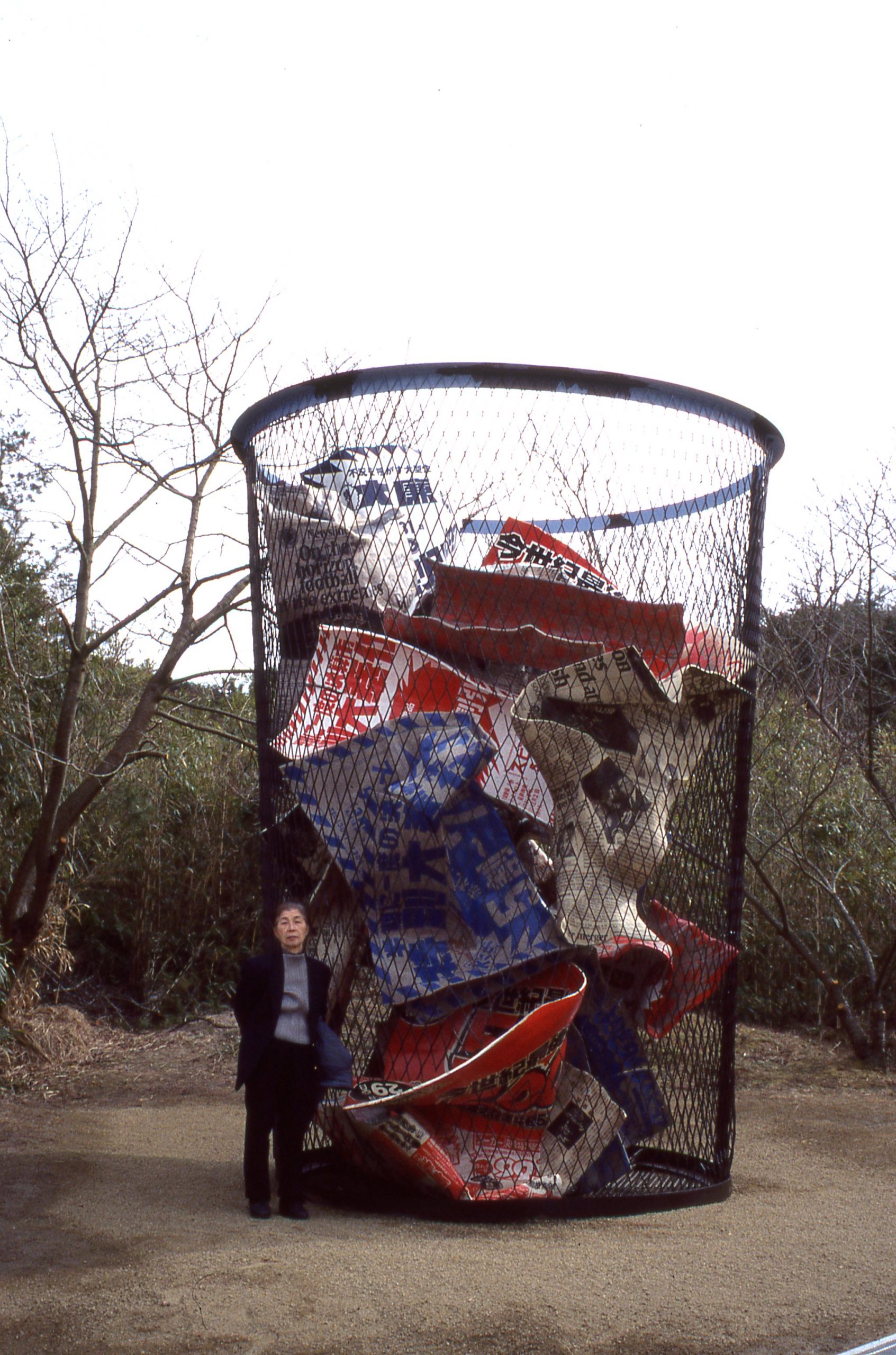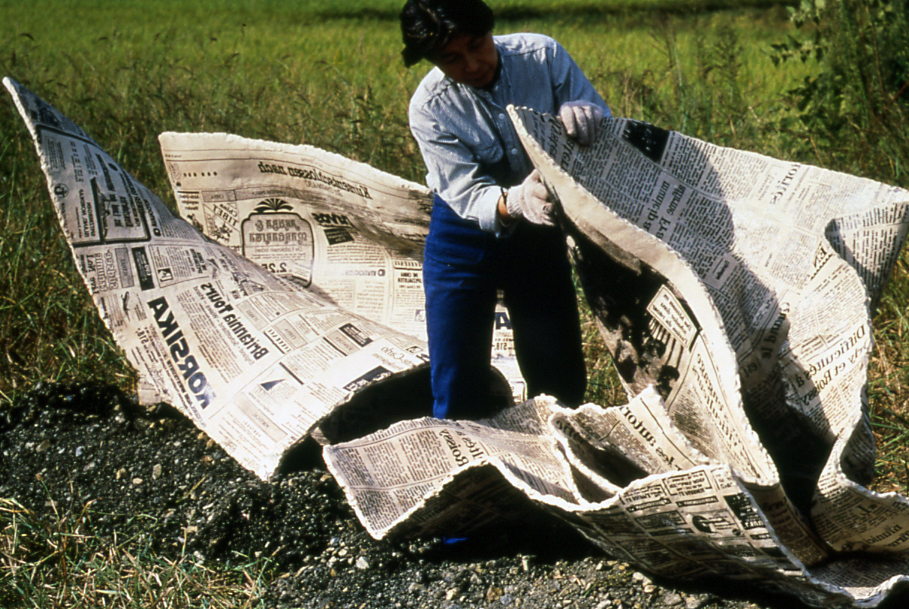三島喜美代 MISHIMA Kimiyo

《もうひとつの再生2005 – N》2001-2005年 廃棄物や下水汚泥の焼却灰等を1400℃以上の高温で溶解して出来た
ガラスのような粉・溶解スラグを素材に制作した巨大なゴミかご 460×350×350cm ベネッセアートサイト直島 蔵Another Rebirth 2005 – N, 2001-2005, Melted slag, iron 460×350×350cm, Collection of Benesse Art Site Naoshima
三島喜美代 MISHIMA Kimiyo
1932年、大阪市生まれ。大阪市に在住、活動。
情報の化石
石田克哉(MEM)
三島喜美代は、自分の作品を「情報の化石」と呼ぶ。
大阪の十三生まれ。高校生のときに油彩を始め独立美術協会の画家に師事する。高校卒業時に、独立美術協会の独立展に出展。後に夫となる画家の三島茂司の薫陶を受け、当初静物画など具象を描いていたが、徐々に抽象に移行していった。そのとき、茂司はアトリエモンターニュという画塾をしており、そこに喜美代も加わる。茂司は、戦前は伊藤継郎、戦後は吉原治良に師事していて、哲学にも詳しく京都大学の聴講生をしていたインテリだったという。ふたりとも身近に、吉原が創設した、具体美術協会の同世代の作家達がいて交流していたが、協会の一員になることはなかった。三島はカンヴァスで実験を始め、雑誌や新聞を絵にコラージュし始める。後にキャンヴァスにシルクスクリーンも併用。茂司が通っていた競馬の馬券も家にどんどん貯まっていたので、それもコラージュに利用したというエピソードがある。
コラージュで使っていた新聞がアトリエの床に丸まって転がっているのを目にとめ、彫刻のアイディアが浮かぶ。絵画コラージュに限界を感じていたこともあり、なにかおもしろい素材はないかと、ガラスやプラスチックなどで試作を始めた。ある日、焼き物だったら落としたら割れると気づき、こわれる緊張感をはらんだ彫刻はおもしろいのではと、陶で作る彫刻の研究を始め、1970-71年陶による新聞の立体作品を試作した。当時、各種新聞に加えファッション、芸能、グラフ誌等ありとあらゆる雑誌が大量に創刊され、人々は貪欲に最新情報をもとめた。新聞や雑誌が大量に捨てられ、情報は知識としてではなく一過性のエンターテイメントとして消費された。三島はそれに恐怖感を抱き、割れさえしなければ永遠に存在する陶の姿に新聞を生まれ変わらせた。それは同時に、壊れる儚いものとして大事に扱わなければいけない。そこがこの作品の重要な点であった。
1972年の銀座の村松画廊での個展で初めて陶による新聞の立体作品を出品する。次に、当時海外の現代美術を積極的に日本に紹介していた南画廊の志水楠男との出会いがあり、1974年に同画廊で個展を開催。床に陶でできた新聞などをごろごろ転がしていたところ、来客のなかにはまだ展示作業中だと誤解した人もいたという。80年頃、今度は陶で制作した新聞等の立体をスケールアップすることを思いつく。現在兵庫県立美術館の山村コレクションにはいっているのは、等身大の陶で制作された電柱や工事現場の柱である。また、巨大な新聞の立体作品は三島のトレードマークになった。
現在直島のベネッセハウスミュージアムの敷地内に設置されているのは、5mの高さに拡大したゴミ籠である。籠にはいっているのは、やはり陶でできた巨大ごみだ。三島は日常のミカン箱や、バナナの箱なども陶の作品として制作するので、日常品を本物そっくりにつくる陶芸家だと誤解されることもある。しかし、実際はゴミをめぐるさまざまな素材を使用し、サイズを変え、形式をかえた幅広い内容の仕事をしてきている。火山灰や、産業廃棄物を高温で処理することで建材として再生利用される溶融スラグ、煉瓦の素材や新聞紙そのもの等。三島の制作プロセスのなかでは、廃棄物も含めた様々な素材がリサイクルされ再生される過程も取り込まれ、そのなかで作品が生まれていく。溶融スラグで制作された立体作品のなかには、産業廃棄物をそっくりに再現したものもある。人間の欲望と功利主義が生み出したものが朽ちてゴミになっていく過程のなかから素材を拾い上げ制作し続けてきた。2020年に開催されたMEMでの新作展では、90年代に火山灰で制作された作品が、廃棄された車の部品等と融合し新しい立体コラージュやレリーフ作品として生まれ変わった。
三島の土岐市にある広い敷地を持つアトリエでは、長年収集し堆積しているありとあらゆるゴミが、時を経て芸術作品として甦るのを待っている。
Born in 1932, Osaka city, Japan. Lives and works in Osaka, Japan.
Fossils of Information
ISHIDA Katsuya(MEM)
Born in Juso, Osaka, Kimiyo Mishima began oil painting under a painter from the Dokuritsu Bijutsu Kyokai while she was in high school. After graduating from high school, she exhibited her work at the Dokuritsu Exhibition, organized by the Dokuritsu Bijutsu Kyokai. Although she gradually moved on to abstract, Mishima started out with representative paintings, such as still lifes, under the painter, Shigeji Mishima, whom she later married. She joined an art school called Atelier Montagne, where Shigeji Mishima, the founder, was teaching. Having studied under Tsuguro Ito before the war, and Jiro Yoshihara after the war, Shigeji Mishima was an intellectual, a special student at Kyoto University and also well versed in philosophy. The couple were both close to their contemporaries in the Gutai group, which Yoshihara founded, although they never became members. Mishima began experimenting with canvas and started collaging magazines and newspapers on paintings. Later, she also tried silkscreen with canvas. There is an interesting anecdote about Mishima using the losing tickets of horse races, accumulated from her husband’s hobby of going to race tracks, for her collage work.
Mishima got her ideas for sculptures from newspapers laying curled up on the floor of her studio that she was using for collage. Facing limits in collage painting, she started searching for unique materials and making prototypes with glass and plastic. One day, she came to realize that ceramic would break if it was dropped. She thought it might be an interesting concept to make a sculpture of a fragile material that requires tender care. So she started studying ceramic sculptures and made prototypes of three-dimensional newspapers in 1970–71. In those days, various newspapers, along with all sorts of magazines, including fashion, entertainment and graphic arts, had largely started making people eager to seek the latest information. Newspapers and magazines were thrown away in droves, and information was consumed, not for knowledge but for passing entertainment. Mishima was alarmed by this, and gave newspapers a new eternal life in ceramic that would last as long as it didn’t break. At the same time, they were delicate insubstantial things that had to be treated with care. That was the point of this work.
In 1972, Mishima presented her first ceramic newspaper sculptures at a solo exhibition at the Muramatsu Gallery in Ginza, Tokyo. She met Kusuo Shimizu of the Minami Gallery, who was devoutly introducing foreign contemporary art to Japan, and held a solo exhibition at the gallery in 1974. Seeing ceramic newspapers and other materials left around on the floor, some visitors mistook it to mean the exhibition was still under preparation. Around 1980, She came up with the idea of scaling up her ceramic newspapers and other three-dimensional objects. Life-sized ceramic telephone poles and large-scale newspapers are currently in the Yamamura Collection at the Hyogo Prefectural Museum of Art. The giant newspaper sculptures have become Mishima’s trademark.
Currently installed on the grounds of the Benesse House Museum in Naoshima is a five meter tall trash can sculpture. Contained in the trash can are giant sheets of waste paper, also made of ceramic. Due to her creations of day-to-day objects, like cardboard boxes of oranges and bananas, Mishima is sometimes misrepresented as a potter who makes realistic everyday objects in ceramic. However, she has been working with a wide range of different ‘garbage-themed’ materials that vary in size and style. These include volcanic ash, bricks, molten slag produced by processing industrial waste at high temperatures and used in building materials, and also actual newspapers. Mishima’s work process includes recycling and regeneration of industrial waste and other various materials. Her works are created through these processes. Some of her three-dimensional projects, made of molten slag, are exact copies of industrial waste. She has continuously picked up and worked with materials in the process of decay caused by human greed and utilitarianism. In her new exhibition at MEM in 2020, her 1990s work using volcanic ash was given new life as three-dimensional collages and reliefs by being fused with scrap car parts and other materials. On a large lot in Toki city in Gifu Prefecture, in Mishima’s studio you will find every type of trash imaginable. After many years, this accumulated collection is awaiting a new life as a work of art.
更新された最新の情報は、作家や画廊のウェブサイトをご覧ください。
Please refer to the following artist’s and the gallery’s website for new updates.
https://mishimakimiyo.com/
https://mem-inc.jp/artists/mishima_j/

《Work 67-A》 1967年 合板にアクリル、新聞、雑誌 183.5×114.3cm
Work 67-A 1967 newspaper, magazine and acrylic on plywood 183.5×114.3cm
 《Copy–83》1975–1982年 印刷したセラミック サイズ可変
《Copy–83》1975–1982年 印刷したセラミック サイズ可変
Copy–83, 1975–1982, Silkscreen on ceramic, Size variable
 左:《Newspaper-84-G》1983年 印刷したセラミック 97×127×95cm 右:《Newspaper-83-F》1982年 印刷したセラミック 102×130×95cm
左:《Newspaper-84-G》1983年 印刷したセラミック 97×127×95cm 右:《Newspaper-83-F》1982年 印刷したセラミック 102×130×95cm
left:Newspaper-84-G, 1983, Silkscreen on ceramic, 97×127×95cm right:Newspaper-83-F, 1982, Silkscreen on ceramic, 102×130×95cm

《Newspaper 08》1997–2008年 ポリエステルにシルクスクリーン 300×1000×1500cm インスタレーション、サイズ可変 アートファクトリー城南島での展示 写真:木奥惠三 写真提供:美術資料センター
Newspaper 08, 1997–2008, Silkscreen on polyester, 300×1000×1500cm, Installation Size variable, Exhibited at ART FACTORY JONANJIMA, Photo by KIOKU Keizo, courtesy Bijutsu Shiryo Center Co.,Ltd.

《Work S – 10》2010年 溶解スラグ、鉄、セラミック、木 180×210×130cm アートファクトリー城南島での展示 写真:木奥惠三 写真提供:美術資料センター
Work S – 10, 2010, Slug of daily life garbage, iron, ceramic, tree 180×210×130cm Exhibited at ART FACTORY JONANJIMA, Photo by KIOKU Keizo, courtesy Bijutsu Shiryo Center Co.,Ltd.

インスタレーション(部分) 2016年 印刷したセラミックに手彩色 サイズ可変
Installation(Detail), 2016, Silkscreen and hand-painted on ceramic, Size variable
All Photos : ©Kimiyo Mishima, courtesy MEM, Tokyo

